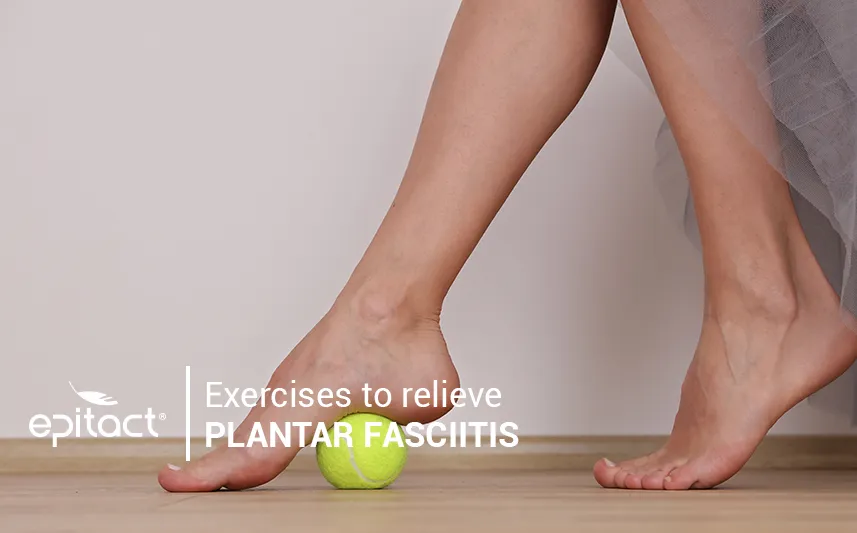
Intense pain under the foot or in the heel can be a symptom of plantar fasciitis. This condition is the inflammation of the fibrous band of tissue that runs along the plantar surface: the plantar fascia. It can be very painful as you walk and practice intense sports.
To solve this problem, several solutions exist to relieve pain and reduce inflammation. Among them, strengthening exercises for plantar fasciitis, stretches and foot massages are recommended.
Exercises for plantar fasciitis: massage or stretches?
Plantar fasciitis is one of the most common musculoskeletal disorders causing pain in the heel. Nowadays, several therapeutic approaches to this condition are well documented and used as a reference. For example, plantar fasciitis stretches are prescribed with a high level of efficiency.
Researches to assess the impact of stretching on pain reduction have proved the benefits of these plantar fasciitis exercises.
One of these studies has demonstrated pain relief (especially in the case of plantar fascia stretching exercises) after 8 weeks. After 2 years, the pain has largely decreased in both groups, without significant difference between them. To conclude, plantar fasciitis stretches focused on the sole are more effective in the short-medium term but no differences were recorded between plantar fasciitis massages and stretching exercises in the long term(2).
4 plantar fasciitis exercises
Two types of exercises have been studied: the first type focuses on the plantar fascia, whereas the second one addresses the Achilles tendon (3). As a complement to these first exercises for plantar fasciitis, EPITACT® shows you another technique that consists in stretching the hamstrings muscles, which helps to prevent the condition.
Plantar fascia stretches: 1st exercise to relieve plantar fasciitis pain
The first exercise for plantar fasciitis consists in stretching the fascia. While seated, place the painful foot on the opposite knee (as if you were crossing your legs), then grab your toes and gently pull them towards you. Make sure to feel the tension in your fascia with your other hand.
Hold this position for 10 seconds and repeat it 10 times, two to three times a day(4). Respect a rest period of 20 seconds between each stretching.


Achilles tendon stretches: 2nd and 3rd plantar fasciitis exercise
The second type of stretches for plantar fasciitis targets the Achilles tendon. You should also feel a stretch in your calf muscle.
To do so, stand upright facing a wall and take a step back with the painful foot. Your feet are perpendicular to the wall. The leg of the affected foot is straight, the other leg is flexed. Keep the heel of the painful foot in contact with the floor and bend forwards by leaning against the wall so that the ankle is flexed. You should feel your tendon stretch.
Another method is to do these plantar fasciitis stretches while seated on the floor, the legs straight. Then pull the ball of your foot backwards thanks to a folded towel. Like the previous exercise, repeat it 10 times for 10 seconds with a rest period of 20 seconds, two to three times per day.


4th exercise for plantar fasciitis: stretches of the thigh muscle
Stretching the hamstrings is also useful because their tightness can aid the development of plantar fasciitis(5). Place your foot on a support with the leg straight to form an angle of 90° between your thigh and trunk. Adapt the height of the support depending on your flexibility. The other leg is straight, the foot flat on the floor.

The association of heel pain with weakness of the foot muscles (intrinsic muscles)(6) is observed. To complete the aforementioned exercises, learn about muscle strengthening exercises for your feet by clicking HERE.
Plantar fasciitis massage with a tennis ball
To relieve plantar fasciitis, massage your foot arch with a tennis ball by rolling it back and forth under your foot. Do not apply too much pressure on your foot.

What should you do in addition to plantar fasciitis stretches?
Now, learn about how to relieve plantar fasciitis pain in addition to doing daily exercises. Indeed, several treatments exist, including preventative techniques, heel lifts, drugs and surgery.
If pain persists, non-steroidal anti-inflammatory drugs can punctually relieve you (like aspirin or ibuprofen).
Wearing heel raises or insoles to relax the fascia and support the arch of the foot is recommended(1). Using the EPITACT® heel lifts* soothes the sensitive area in the case of plantar fasciitis. EPITACT® suggests these shock absorbers intended to reduce shock waves and decrease the stress on the plantar fascia causing pain.
They are made up of two unique materials: the PHYSIO’CHOC™ which is an excellent shock absorber and the silicone that reduces pressure on the painful area in the heel. This solution provides great comfort during walking.
Finally, if these treatments combined with physiotherapy exercises for plantar fasciitis and corticosteroid injections in the heel are insufficient, surgery is considered.
However, to avoid the condition worsening, doing simple stretches for plantar fasciitis and massage techniques can have very positive effects. Try to do them on a daily basis to reduce your symptoms and wear the EPITACT® heel lifts* to ease the inflammation.

*This solution is a class I medical device that bears the CE marking under this regulation. Carefully read the instructions before use. Manufacturer: Millet Innovation. 10/2021
For more details about this general and simplified approach, here are further sources:
(1)Martin RL, Davenport TE, Reischl SF, McPoil TG, Matheson JW, Wukich DK, et al. Heel Pain—Plantar Fasciitis: Revision 2014. J Orthop Sports Phys Ther. nov 2014;44(11):A1 33.
(2)Digiovanni BF, Nawoczenski DA, Malay DP, Graci PA, Williams TT, Wilding GE, et al. Plantar Fascia-Specific Stretching Exercise Improves Outcomes in Patients with Chronic Plantar Fasciitis : A prospective clinical trial with two-year follow-up. VO LUM E. août 2006;88-A(8):7.
(3)DiGiovanni BF, Nawoczenski DA, Lintal ME, Moore EA, Murray JC, Wilding GE, et al. Tissue-specific plantar fascia-stretching exercise enhances outcomes in patients with chronic heel pain. A prospective, randomized study. J Bone Joint Surg Am. juill 2003;85(7):1270 7.
(4)Lafuente Guijosa A, O’Mullony Muñoz I, Escribá de La Fuente M, Cura-Ituarte P. Plantar Fasciitis: Evidence-Based Review of Treatment. Reumatología Clínica (English Edition). janv 2007;3(4):159 65.
(5)Labovitz JM, Yu J, Kim C. The role of hamstring tightness in plantar fasciitis. Foot Ankle Spec. juin 2011;4(3):141 4.
(6)Huffer D, Hing W, Newton R, Clair M. Strength training for plantar fasciitis and the intrinsic foot musculature: A systematic review. Physical Therapy in Sport. mars 2017;24:44 52.
 Pharmacie
Pharmacie